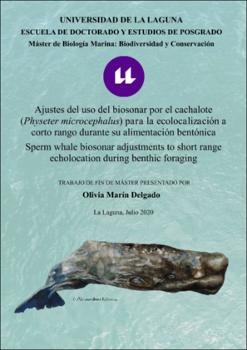Ajustes del uso del biosonar por el cachalote (Physeter microcephalus) para la ecolocalización a corto rango durante su alimentación bentónica
Author
Marín Delgado, OliviaDate
2021Abstract
Los cachalotes producen los sonidos más potentes del reino animal, lo que les permite
ecolocalizar presas mesopelágica a larga distancia. Cuando alternan entre nichos de forrajeo
pelágicos y bentónicos-bentopelágicos, se plantea la cuestión de cómo este potente biosonar
opera en un entorno tan reverberante como el bentónico. Para probar la hipótesis de que
durante la alimentación bentónica los cachalotes podrían ecolocalizar más rápido y a menores
niveles de emisión que en el ambiente pelágico, utilizamos datos de marcas multisensor
DTAG colocadas con ventosas en tres cachalotes del Mediterráneo. Los cachalotes
aumentaron la tasa de emisión de chasquidos durante la alimentación bentónica, con un
intervalo entre chasquidos un 10, 23 y 31% más largo durante las inmersiones pelágicas. Esto
fue asociado a una reducción de los niveles de emisión de los chasquidos durante las
inmersiones bentónicas. Estos ajustes podrían servir para reducir el enmascaramiento por las
reverberaciones del fondo marino y para proporcionar tasas de actualización más rápidas de
las presas en una escena auditiva limitada por la corta distancia al fondo. Concluimos que los
cachalotes, al igual que otros odontocetos, pueden emplear ajustes contextuales en su biosonar
y en su espacio acústico activo para facilitar la caza en diferentes hábitats de alimentación. Sperm whales produce the most powerful sounds in the animal kingdom for longrange echolocation of mesopelagic prey during long and deep dives. Occasionally, sperm
whales switch from pelagic to benthic-benthopelagic foraging at or near to the highly
reflective seafloor, raising the question of how the most powerful biosonar system in the
world is operated in such a highly reverberant environment. Based on scarce data from small
toothed whales, we hypothesized that sperm whales foraging near the seafloor echolocate
faster with weaker outputs. To test that hypothesis, we used data from sound and movement
recording DTAGs deployed on three Mediterranean sperm whales performing both benthic
and pelagic foraging dives. The three whales reduced their click rate during benthic foraging,
using 10, 23 and 31 % longer inter-click interval during pelagic dives. This was accompanied
by a reduction of the apparent output levels during benthic dives.These adjustments likely
serve as an adaptation to reduce backwards masking from sea floor reverberations, and to
provide faster update rates for short target echo delays in a smaller auditory scene framed by
the nearby sea floor. We conclude that sperm whales, like smaller toothed whales, can employ
contextual adjustments of their biosonar sampling and acoustic gaze to facilitate prey target
interception in different foraging habitats.




